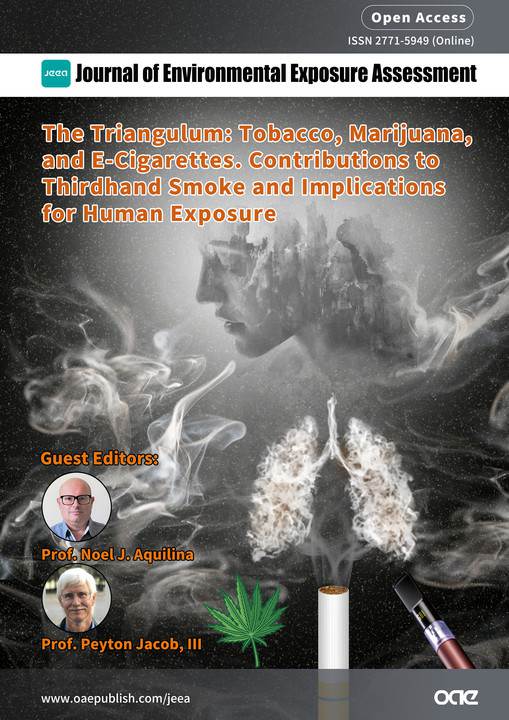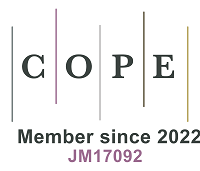
Topic: The Triangulum: Tobacco, Marijuana, and E-Cigarettes. Contributions to Thirdhand Smoke and Implications for Human Exposure
A Special Topic of Journal of Environmental Exposure Assessment
ISSN 2771-5949 (Online)
Submission deadline: 31 Dec 2024
Guest Editors
Special Topic Introduction
Triangulum is triangle in Latin, a term that is being used to represent the overlap of tobacco, marijuana, and electronic cigarettes in today's smoking habits and their consequences.
While over the last half century, the level of scientific understanding of tobacco chemistry has increased substantially, as also the knowledge about the exposure mechanisms and the harm cigarette smoking and secondhand smoke causes, the same cannot be said of the links between the exposure to thirdhand smoke (THS: tobacco smoke residues in indoor environments that remain, react and/or re-emit from materials and/or re-suspend from surfaces) and the health implications. Complicating matters further, today's realities are not limited solely to tobacco smoke, but that different age groups in diverse communities are exploring new avenues. Today's appeal gravitates towards the use of electronic cigarettes and marijuana, a landscape that is changing very fast.
It appears that e-cigarettes and other electronic nicotine delivery systems (ENDS) are increasingly popular as the main delivery device for a variety of flavoured aerosols, with or without nicotine. These include heat-not-burn products that deliver nicotine and other substances from tobacco without combustion, vaping devices containing liquid THC and synthetic cannabinoids, hookah pens that deliver aerosolized mixtures that mimic those delivered by hookah water pipes, and electronic cigars. Aerosols from these new products contribute to the THS derived from combusted tobacco products such as cigarettes, cigars, blunts and spliffs.
This means that scientists, public health officials, and policy makers need to respond to the implications of human exposure, which is certainly different from combusted tobacco alone, and for which there is not enough breadth of research because this is an area that is still in its infancy. Given these fast-changing scenarios, advancement in science is necessary on several fronts, such as:
● Chemical characterisation of the residues of these commonly used mixtures in ENDS and/or mixed marijuana & tobacco left in indoor and outdoor environments;
● Improvement of methodology to measure thirdhand smoke exposure via different routes;
● Personal exposure studies within different communities and demographic groups;
● Biomarker studies to evaluate the levels of exposure to the myriad of compounds derived from these various products;
● Clinical studies of exposure to the thirdhand smoke triangulum and health effects, including studies of the cross-over use of these multiple products and how they influence health and/or behaviour.
We call for manuscripts from research institutes, academia, and industry related to research in the abovementioned areas. Contributions from public authorities are also welcome, since the scientific topics and implications are challenging and may require input from various stakeholders in developing policies needed for regulatory purposes.
Note: Any new studies on tobacco, marijuana, or e-cigarettes would be welcomed, as long as they focus on environmental contamination and exposures.
All submissions MUST consider the implications for human and/or wildlife exposure to contaminants. Please see the Aims and Scope of JEEA for further guidance.
While over the last half century, the level of scientific understanding of tobacco chemistry has increased substantially, as also the knowledge about the exposure mechanisms and the harm cigarette smoking and secondhand smoke causes, the same cannot be said of the links between the exposure to thirdhand smoke (THS: tobacco smoke residues in indoor environments that remain, react and/or re-emit from materials and/or re-suspend from surfaces) and the health implications. Complicating matters further, today's realities are not limited solely to tobacco smoke, but that different age groups in diverse communities are exploring new avenues. Today's appeal gravitates towards the use of electronic cigarettes and marijuana, a landscape that is changing very fast.
It appears that e-cigarettes and other electronic nicotine delivery systems (ENDS) are increasingly popular as the main delivery device for a variety of flavoured aerosols, with or without nicotine. These include heat-not-burn products that deliver nicotine and other substances from tobacco without combustion, vaping devices containing liquid THC and synthetic cannabinoids, hookah pens that deliver aerosolized mixtures that mimic those delivered by hookah water pipes, and electronic cigars. Aerosols from these new products contribute to the THS derived from combusted tobacco products such as cigarettes, cigars, blunts and spliffs.
This means that scientists, public health officials, and policy makers need to respond to the implications of human exposure, which is certainly different from combusted tobacco alone, and for which there is not enough breadth of research because this is an area that is still in its infancy. Given these fast-changing scenarios, advancement in science is necessary on several fronts, such as:
● Chemical characterisation of the residues of these commonly used mixtures in ENDS and/or mixed marijuana & tobacco left in indoor and outdoor environments;
● Improvement of methodology to measure thirdhand smoke exposure via different routes;
● Personal exposure studies within different communities and demographic groups;
● Biomarker studies to evaluate the levels of exposure to the myriad of compounds derived from these various products;
● Clinical studies of exposure to the thirdhand smoke triangulum and health effects, including studies of the cross-over use of these multiple products and how they influence health and/or behaviour.
We call for manuscripts from research institutes, academia, and industry related to research in the abovementioned areas. Contributions from public authorities are also welcome, since the scientific topics and implications are challenging and may require input from various stakeholders in developing policies needed for regulatory purposes.
Note: Any new studies on tobacco, marijuana, or e-cigarettes would be welcomed, as long as they focus on environmental contamination and exposures.
All submissions MUST consider the implications for human and/or wildlife exposure to contaminants. Please see the Aims and Scope of JEEA for further guidance.
Submission Deadline
31 Dec 2024
Submission Information
For Author Instructions, please refer to https://www.oaepublish.com/jeea/author_instructions
For Online Submission, please login at https://www.oaecenter.com/login?JournalId=jeea&IssueId=jeea2412311303
Submission Deadline: 31 Dec 2024
Contacts: Smart Zhang, Managing Editor, [email protected]








